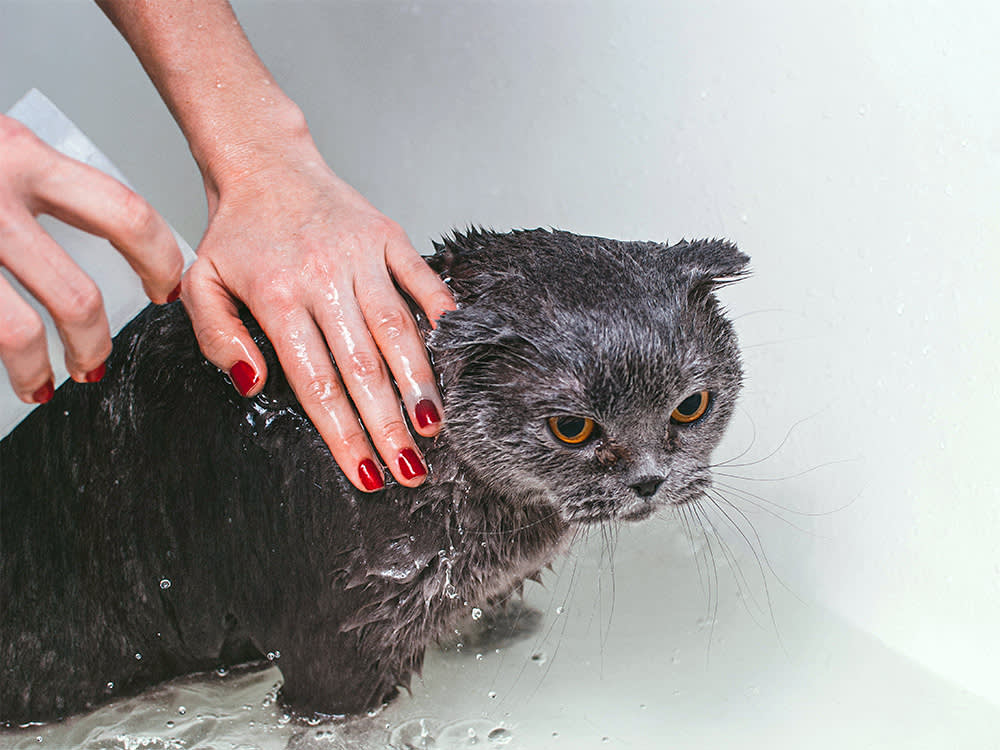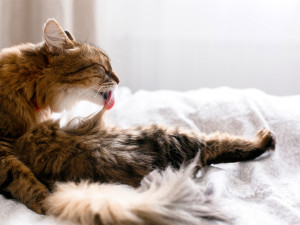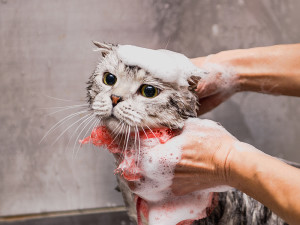
Share Article
In This Article:
Is Bathing Your Cat Important?opens in a new tab How To Bathe Your Catopens in a new tab How To Avoid Scratching During Bath Timeopens in a new tab Tips For Bathing Your Catopens in a new tab Not All Cats Hate Wateropens in a new tab
Deciding to give your cat a bath can quickly turn into a nightmare full of slippery struggles and soaked furniture. You tried to do something nice for them, but now they’re sopping wet and you’re full of scratches, and also ugly crying — it’s not a good look for anyone. But do you actually need to bathe your cat?
You might be surprised to learn that kitty bathtime isn’t always a necessity. In fact, for many cat breeds, it’s a rare occurrence. But every cat is different, and some may find themselves in need of a good scrub more often than others. Whether your whiskered friend is an occasional dirt magnet or a self-grooms like a pro, we’ve got you covered with tips and tricks to make bathtime a breeze.

littleKin™ is Kinship’s home just for puppy and kitten parents. Bop over to check out expert advice, new pet tools, and special deals—all curated for your newest family member.
opens in a new tabDo cats need baths?
If trying to give your cat a bath is like wrangling a balloon in a windstorm, there’s good news — unless you have a hairless breed, you likely don’t need to be bathing them regularly, or maybe even at all. Cats naturally groom themselves, and unless it’s an emergency situation, the vast majority of them can skip bathtime.
“The average pet cat does not ever need to be bathed,” says Laura Cassiday, a certified cat behavior consultant at Pawsitive Vibes Cat Behavior & Trainingopens in a new tab. “Baths should be saved for emergencies, like the cat peed on themselves in their carrier, or they got some type of dangerous chemical on their fur.”
For most situations outside of an emergency, Cassiday suggests using waterless shampoo or pet wipes, and these will get your cat as clean as they need to be. There are a few breeds, however, that do require frequent bathing.
“The Sphynx and other hairless breeds are the only cats who truly require regular bathing, generally every week to every other week,” Cassiday says. “They also need their ears and nail beds cleaned, as they have no hair to prevent dirt from getting trapped inside.”
She explains that though Sphynxes don’t shed, they will leave brown oily stains all over your home if they haven’t been bathed recently. Hey, you probably would too if you didn’t bathe every day. Other breeds that may need occasional baths include the Persianopens in a new tab, with its long, luxurious coat prone to matting, and the Maine Coon, known for its water-resistant fur and propensity for exploring the great outdoors.
How to bathe your cat
For cat parents with hairless breeds, you’ll need to become a cat-bathing pro if you want to keep your naked feline happy and healthy (and you know, save your furniture from brown oil stains). Follow these steps to give your kitty a bath, sans the drama.
Gather supplies.
Before you even turn on that faucet, you need to make sure you have the right supplies to get the job done. It’s best to use shampoo that’s specially formulated for cats, ensuring it won't irritate their skin. You should also have a towel handy for drying off afterward and plenty of treats to reward them for their cooperation throughout the process. Oh yeah, the other thing you’ll need is your cat. They may be hidingopens in a new tab, so try to gently lure them into the bathroom with a treat.
Run the bath.
Now it’s time to run the water. The bath water temperature for a cat should be comfortably warm, similar to what you would use for a baby. Test it with your wrist or elbow to ensure it’s not too hot and avoid extremes in temperature to prevent scalding or discomfort.
“I fill up my bathtub with maybe three to four inches of water and squirt the shampoo directly into the water, then mix it up until it’s bubbly,” Cassiday says.
Lather and rinse
If you already have bubbly water, you can start pouring small amounts of water on your cat. You can also choose to squirt the shampoo directly on your kitty and lather them that way.
“I use a small cup to slowly pour water along the cat until everything is wet, then I lather up, adding additional shampoo if necessary,” Cassiday adds. “Then, I start the bath water again and pour fresh cups of water on the cat to rinse out. For my cat, I am consistently rewarding him with Churuopens in a new tab the entire time, not just at the end.”
Fluff and dry.
Once you've rinsed off all the shampoo, grab a dry towel and gently pat your kitty dry. Avoid vigorous rubbing, as this can cause discomfort or tangle their fur. If your cat tolerates it, you can also use a low setting on a pet-safe hairdryer to speed up the drying process. Make sure they’re completely dry before allowing them to go back outside or curl up in their favorite spot and give you the evil eyeopens in a new tab.
How to avoid getting scratched during bathtime
Most cats do not look forward to bathtime, so there’s always the risk that you’ll get scratchedopens in a new tab during the process. Thankfully, there are ways to mitigate cat scratchingopens in a new tab and create a calmer environment for tub time.
“To reduce stress, I try not to manhandle, scruff, or use forceful restraint on any cat I’m bathing,” Cassiday says. “Scruffing and rough handling can increase fear and aggression and cause your cat to panic and struggle even more. I try to use gentle control, using the least amount of restraint needed, and have a helper if the cat is particularly not having a good time.”
Cassiday explains that it can be helpful for one person to hold the kitty while the other bathes them. She recommends facing the cat towards the wall and placing their front paws on the ledge. That way, teeth and claws are facing away from you.
“A non-slip mat at the bottom of the tub can help your cat feel more secure as well,” Cassiday says. “I always let my Sphynx lick from a Churu while he is in the tub to make it a more positive experience for him, and he generally does not require any restraint while he is happily licking away — even though he is still not a bathtime fan.”
More tips for giving your cat a bath
The reality is that bathing can be traumatic for most cats, so it’s important to do everything you can to make it as stress-free as possible. Follow these tips to make your cat’s next bath a calming one instead of a chaotic catastrophe:
Start bathing them young.
Gradually introduce them to water.
Give lots of praise and treats.
Consider clicker training for catsopens in a new tab to reward good behavior.
Don’t use forceful restraint.
Keep the water comfortably warm.
Get a buddy to help you.
Stay calm, your cat can sense your stressopens in a new tab.
Know that not all cats hate water
Contrary to popular belief, not all cats hate water. Some breeds, like the Maine Coon and Turkish Van, actually enjoy it. Plus, individual personalities play a big role. While some kitties may be hesitant at first, with gentle introduction and positive reinforcement, many can learn to tolerate or even enjoy water. Understanding your cat’s preferences and respecting their comfort level is key to successful bathing.
FAQs (People also ask):
Are there any products that make bathing a cat easier?
Yes, there are several products that can streamline the cat-bathing process and make it more comfortable for your cat: non-slip bath mats, high-reward treats, and grooming gloves and brushes are all great optionsopens in a new tab. Consider investing in specially formulated cat shampoo, designed to be gentle on their skin and coat.
How can I make baths less stressful for my cat?
Yes, you can make baths less stressful for your cat in several different ways. First, ensure you’re using a gentle, cat-specific shampoo to avoid skin irritation. Create a calm and quiet environment by eliminating loud noises and distractions. Offer treats and praise throughout the process to reinforce positive associations with bath time. Finally, be patient and gentle.
Do different cat breeds have different bathing considerations?
Yes, different cat breeds may have varying bathing considerations based on factors such as coat type, length, and density. Breeds with longer or thicker coats, such as Persians or Maine Coons, may require an occasional bath to prevent matting and tangling. Breeds with oilier skin, such as Sphynx cats, may benefit from more frequent baths to manage oil buildup.
How often should I brush my cat?
Generally, brushing your cat a few times a week is sufficient for most breeds to maintain their coat’s health and appearance. However, during shedding seasons, such as spring and fall, more frequent brushing may be necessary to manage loose fur and minimize hairballs.
References:

Jackie Brown
Jackie Brown lives in sunny Orange County, CA, where she works as a freelance writer and editor. When she’s not on deadline, you can find her paddling her outrigger canoe in the Pacific Ocean or hiking in the foothills with her miniature poodle and two young boys.
Related articles
![Cat being washed by a groomer]() opens in a new tab
opens in a new tabDoes My Cat Need a Professional Groomer?
If you thought your cat was a self-cleaning evolutionary marvel, you’re not wrong but...
![Cat enjoying laying on girl's legs and being cuddled]() opens in a new tab
opens in a new tabNew Research Aims to Reduce Cat Stress During Nail Trims
Plus, expert advice on how to trim your cat’s nails at home.
![brown cat in grass]() opens in a new tab
opens in a new tabHairballs: A Tangled Web
What to do when your cat hawks one up.
![Fluffy orange cat sitting on beige couch]() opens in a new tab
opens in a new tabThe Best Cat Hair Removal Products to Comb Through
Cat hair...everywhere? These essential tools will whisk it away.







